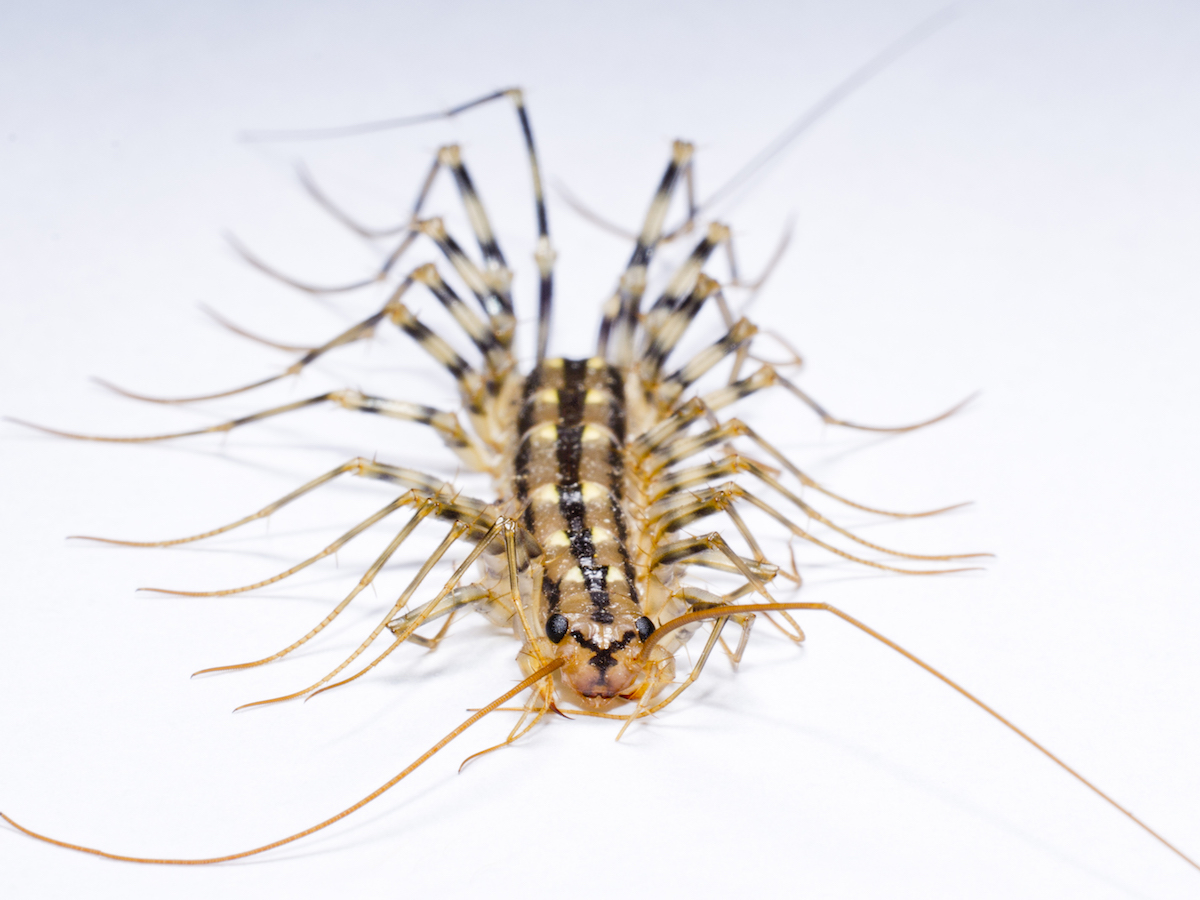Table Of Content
You can find one near you with the helpful zip code search below. Some of the plates covering the body segments fused and became smaller during the evolution to the current state of S. The resulting mismatch between body segments and dorsal plates (tergites) is the cause for this centipede's rigid body. Dear Malia, Though it looks quite fearsome, this common House Centipede is actually a shy nocturnal hunter. It is a beneficial creature that will help keep the Cockroach population down.
Is a Scorpion Fly Dangerous? Uncovering the Truth About This Intriguing Insect
If a common household centipede gets scared and bites you, you might feel a slight pinch. This critter is a common household pest, seeking out a moist environment and solid food source in the comforts of your home. While not overly dangerous to people, a centipede might not be a welcomed guest. The average centipede lays around 63 eggs and a maximum of around 151 eggs.
Types of Centipedes
House centipedes feed on silverfish, firebrats, carpet beetle larvae, cockroaches, spiders, and other small arthropods. If house centipedes are seen frequently, this indicates that some prey arthropod is in abundance, and may signify a greater problem than the presence of the centipedes (Figure 3). Centipedes are sometimes called house centipedes or "hundred-leggers" because of their many pairs of legs. They are widely distributed throughout most of United States and the world.
Where Do House Centipedes Live?
Remove piles of leaves and grass clippings, logs, stones and rocks on your property. Provide adequate ventilation in basements, attics and crawl spaces. Seal holes, cracks and gaps that enable outdoor centipedes to get inside a home. Centipedes are generally considered nuisance pests, as they do not pose significant health or property threats. However, all house centipedes have poison jaws with which they inject venom into their prey.
As generalist carnivores, they will attack any soft-bodied creature they feel capable of killing and eating. Centipedes can have a few dozen pairs of legs to a few hundred, which is how they got their name. In Latin, “centi” refers to 100, and “ped” or “pedis” mean feet. Whenever this insect is around your home, its speed and legs can be a discomforting sight. Unlike its shorter-legged but much larger tropical cousins, the house centipede can live its entire life inside a building. Centipedes typically overwinter outdoors in protected situations and lay their eggs during the summer, usually in or on the soil.
House Centipedes Use Their Legs Like Lassos to Catch Prey - Mentalfloss
House Centipedes Use Their Legs Like Lassos to Catch Prey.
Posted: Fri, 05 Oct 2018 07:00:00 GMT [source]
They are classified with Insects in the phyllum Arthropoda. Remove leaves and weeds and seal cracks to prevent any seepage of moisture into your home. Centipedes are nocturnal, leaving their daytime cover to find food. They will enter a house through cracks or openings in the foundation, so checking your home for unwanted entrances is crucial to establishing a pest-free home. In North America, you most often will find centipedes outside in moist locations, hiding under protective areas such as stones, leaves, and logs. They will also come indoors, so it’s not unusual to find one in your house.
Signs You Have a House Centipede Infestation

Centipedes typically leave no direct signs of an infestation other than the sighting of the pest itself. Hi Again Fred, Many years ago we posted a similar looking Cave Centipede from Borneo, and there are also similar Centipedes from Vietnam in our archives. Though they are not in homes, we do classify them with the House Centipedes. Mary Marlowe Leverette is one of the industry's most highly-regarded housekeeping and fabric care experts, sharing her knowledge on efficient housekeeping, laundry, and textile conservation. She is also a Master Gardener with over 40+ years of experience and 20+ years of writing experience. Mary is also a member of The Spruce Gardening and Plant Care Review Board.
Where are you likely to find centipedes?
Using their legs to beat prey has also been described.[8] Like other centipedes they can stridulate. Discovering a population of centipedes in your home could indicate other insects sharing your home. House centipedes will only stay where they have an ample food source.
The house centipedes venom is too weak to cause any serious harm to larger pets such as cats and dogs. Harborage reduction is the second most important management tactic. With appropriate fillers, fill or seal cracks and crevices in concrete slabs and block walls. Install window screen in basement floor drains to prevent centipedes from entering from dry sumps. Centipedes are nocturnal creatures that hide in dark, damp, and cool places during the daytime and venture out in the dark to hunt.
Inside the home, they can be found in bathrooms and lavatories, which tend to be humid, but they can also be found in drier places like offices, bedrooms and dining rooms. They are usually seen crawling along the ground or floor, but they are capable of climbing walls. The greatest likelihood of encountering them is in spring, when they emerge due to warmer weather and in autumn/fall, when the cooling weather forces them to seek shelter in human habitats. Although they can look disgusting to some, they don’t harm humans. On the contrary, they help you by preying on other common household pests such as cockroaches, silverfish, firebrats, carpet beetle larvae, spiders, termites, bed bugs, and other small arthropods.
For example, while hunting, house centipedes use their long legs to trap their prey and inject venom to paralyze them. House centipedes feed on bedbugs, termites, cockroaches, silverfish, spiders and other household pests. They kill their prey by injecting venom through their fangs and then eating the dead prey. Adult house centipedes have 15 pair of legs with the last pair (on adult females) nearly twice the length of the body, which is one to one and one-half inches in length (Figure 1). This gives the centipede an overall appearance of being from three to four inches in length (including legs and antennae). The legs are banded light and dark, and the body is a dirty yellow with three longitudinal, dark stripes.
While millipedes do closely resemble centipedes, millipedes are herbivores and detritivores, surviving on dead and decaying plant material, including wood or cellulose material. Although house centipedes are “good” bugs, they may still make your skin crawl. If you don’t want to share your home with them, rather than squash them, relocate them outside, where they’ll continue to provide pest control. Trap a centipede the same way you would a spider, by dropping a cup or jar over it and then sliding a piece of paper underneath to seal it inside. House centipedes are predators that mainly feed on insects, including spiders, silverfish, and cockroaches.
Coleoptrata has developed automimicry in that its tail-like hind legs present the appearance of antennae. When the centipede is at rest, it is not easy to tell its cranial end from its caudal end. Since centipedes are nocturnal, it can be tough to determine whether you have them in your house.
Empty the vacuum cup or vacuum bag into a sealable plastic bag and dispose of it in an outdoor trash can. Because house centipedes help you control infestations of other, more bothersome pests, there’s little reason to exterminate them. Pesticides are of limited effectiveness in eliminating house centipedes. With their long legs, they hold their bodies high when they move, allowing them limited contact with pesticide-laden surfaces, making most pesticides less effective. The house centipede (Scutigera coleoptrata) is the most common centipede found in the U.S. These centipedes are sometimes referred to as “hundred-leggers,” due to their many pairs of legs.
In summary, protecting your home from house centipedes involves sealing entry points, removing pest attractants, and maintaining a dry home environment. By following these steps, your home will become less appealing to these pests, ultimately keeping it centipede-free. To prevent house centipedes from entering your home, seal cracks and gaps in doors, windows, and walls. One example of sealing entry points is using weather-stripping on doors and caulking around windows. House centipedes can’t enter if there are no openings for them to pass through. If you see house centipedes emerging from various cracks or crawl spaces, try using a high-powered vacuum cleaner to suck them out.

No comments:
Post a Comment